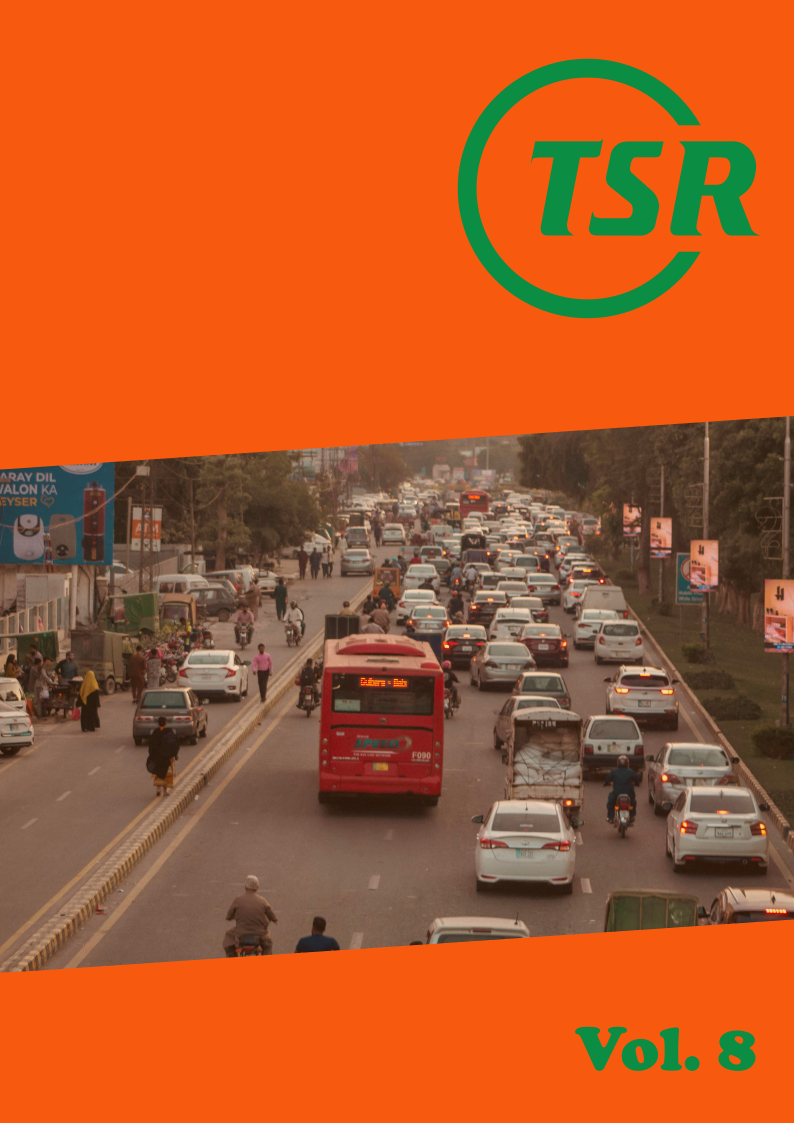Pedestrians' attributions of risk and safety in traffic: case of Türkiye
DOI:
https://doi.org/10.55329/xmqd4969Keywords:
causal attributions, causal dimensions, low- and middle-income countries (LMICs), road safety, vulnerable road usersAbstract
Pedestrians constitute between 17%–33% of all road traffic deaths depending on the region. For this reason, factors influencing the risky as well as safe behaviours of pedestrians need to be examined. The current study aims to understand risk and safety attributions of this road user group. A total of 254 pedestrians aged between 18 and 68 participated in the study. The participants filled out a demographic information form and Causal Dimension Scale-II (CDSII), which is composed of a qualitative and a quantitative part. CDSII is a self-report measure assessing how individuals evaluate the causes of events in various dimensions. The CDSII was filled out twice by the respondents: once for the riskiest and once for the safest situations experienced as a pedestrian. For 6 out of 9 situations in which pedestrians feel at risk, the most common reason was problematic drivers. Elimination of and decrease in crash risk were the most important reasons for feeling safe in areas separating pedestrians and drivers. The results showed that there is a difference between causal evaluations of risky and safe situations. The findings of this study point out to several points that require attention. One of these is the driver-pedestrian interactions. To overcome this, effective enforcement and well-functioning infrastructural improvements can be suggested.
Downloads
References
Alatawneh, A., & Ghunaim, D. (2024). Towards vehicle electrification: A mathematical prediction of battery electric vehicle ownership growth, the case of Turkey. Green Energy and Intelligent Transportation, 3(4), 100166. DOI: https://doi.org/10.1016/j.geits.2024.100166
Bendak, S., Alnaqbi, A. M., Alzarooni, M. Y., Aljanaahi, S. M., & Alsuwaidi, S. J. (2021). Factors affecting pedestrian behaviors at signalized crosswalks: An empirical study. Journal of Safety Research, 76, 269–275. DOI: https://doi.org/10.1016/j.jsr.2020.12.019
Boun, S. S., Janvier, R., Marc, R. E. J., Paul, P., Senat, R., Demes, J. A. E., Burigusa, G., Chaput, S., Maturice, P., & Druetz, T. (2024). Environmental measures to improve pedestrian safety in low- and middle-income countries: A scoping review. Global Health Promotion, 31(4), 1757–9759. DOI: https://doi.org/10.1177/17579759241241513
Çıkrıkçı, N., Yalçın, S., Ayan, C., Şahin Kürşad, M., & Kamış, Ö. (2021). Trafikten şikâyetim var! Yaya ve sürücü gözüyle. Trafik ve Ulaşım Araştırmaları Dergisi, 4(1), 15–27. DOI: https://doi.org/10.38002/tuad.792869
Demir, B., Özkan, T., & Demir, S. (2019). Pedestrian violations: Reasoned or social reactive? Comparing theory of planned behavior and prototype willingness model. Transportation Research Part F: Traffic Psychology and Behaviour, 60, 560–572. DOI: https://doi.org/10.1016/j.trf.2018.11.012
Dinh, D. D., Vu, N. H., McIlroy, M. C., Plant, K. A., & Stanton, N. A. (2020). Examining the roles of multidimensional fatalism on traffic safety attitudes and pedestrian behaviour. Safety Science, 124, 104587. DOI: https://doi.org/10.1016/j.ssci.2019.104587
Esmaili, A., Aghabayk, K., Parishad, N., & Stephens, A. N. (2021). Investigating the interaction between pedestrian behaviors and crashes through validation of a pedestrian behavior questionnaire (PBQ). Accident Analysis & Prevention, 153, 106050. DOI: https://doi.org/10.1016/j.aap.2021.106050
European Commission. (2025). Annual statistical report on road safety in the EU, 2025. European Commission, Directorate General for Transport: European Road Safety Observatory.
Fındık, G. (2023). ‘The best, the worst, and the avoidant: The relationship between causal and affective evaluations about driving performance and self-regulatory driver behaviors’ [PhD thesis]. Middle East Technical University.
Fındık, G., Özbay, İ., Öz, B., Lajunen, T., & Özkan, T. (2023). The relationship between traffic-related causal attributions and human factors in driving. New Trends in Psychology, 5(2), 117–136.
Hashemiparast, M., Negarandeh, R., & Montazeri, A. (2017). How young pedestrians do explain their risky road crossing behaviors? A qualitative study in Iran. Health Promotion Perspectives, 7(3), 140–144. DOI: https://doi.org/10.15171/hpp.2017.26
Karaaslan, E., Noori, M., Lee, J. Y., Wang, L., Tatari, O., & Abdel-Aty, M. (2018). Modeling the effect of electric vehicle adoption on pedestrian traffic safety: An agent-based approach. Transportation Research Part C: Emerging Technologies, 93, 198–210. DOI: https://doi.org/10.1016/j.trc.2018.05.026
Kaygısız, Ö., Yıldız, A., & Düzgün, Ş. (2015). Spatio-temporal pedestrian accident analysis to improve urban pedestrian safety: The case of the Eskişehir Motorway. Gazi University Journal of Science, 28(4), 623–630.
Kuşkapan, E., Alemdar, K. D., Kaya, Ö., & Çodur, M. Y. (2019). Traffic accidents caused by pedestrians in Turkey. International Journal for Traffic and Transport Engineering, 9(1), 118–126. DOI: https://doi.org/10.7708/ijtte.2019.9(1).09
Liu, M., Wu, J., Yousaf, A., Wang, L., Hu, K., Plant, K. L., McIlroy, R. C., & Stanton, N. A. (2021). Exploring the relationship between attitudes, risk perceptions, fatalistic beliefs, and pedestrian behaviors in China. International Journal of Environmental Research and Public Health, 18(7), 3378. DOI: https://doi.org/10.3390/ijerph18073378
McAuley, E., Duncan, T. E., & Russell, D. W. (1992). Measuring causal attributions: The Revised Causal Dimension Scale (CDSII). Personality and Social Psychology Bulletin, 18, 566–573. DOI: https://doi.org/10.1177/0146167292185006
McIlroy, R. C., Kokwaro, G. O., Wu, J., Jikyong, U., Hoai, N. V., Hoque, M. S., Preston, J. M., Plant, K. L., & Stanton, N. A. (2020). How do fatalistic beliefs affect the attitudes and pedestrian behaviours of road users in different countries? A cross-cultural study. Accident Analysis & Prevention, 139, 105491. DOI: https://doi.org/10.1016/j.aap.2020.105491
Nikolaou, D., Ntontis, A., Michelaraki, E., Ziakopoulos, A., & Yannis, G. (2023). Pedestrian safety attitudes and self-declared behaviour in Greece. IATSS Research, 47(1), 14–24. DOI: https://doi.org/10.1016/j.iatssr.2022.12.002
Noland, R. B., Klein, N. J., & Tulach, N. K. (2013). Do lower income areas have more pedestrian casualties? Accident Analysis & Prevention, 59, 337–345. DOI: https://doi.org/10.1016/j.aap.2013.06.009
Nordfjærn, T., & Şimşekoğlu, Ö. (2013). The role of cultural factors and attitudes for pedestrian behaviour in an urban Turkish sample. Transportation Research Part F: Traffic Psychology and Behaviour, 21, 181–193. DOI: https://doi.org/10.1016/j.trf.2013.09.015
Nordfjærn, T., Şimşekoğlu, Ö., & Rundmo, T. (2012). A comparison of road traffic culture, risk assessment and speeding predictors between Norway and Turkey. Risk Management, 14(3), 202–221. DOI: https://doi.org/10.1057/rm.2012.5
Nordfjærn, T., Şimşekoğlu, Ö., Zavareh, M. F., Hezaveh, A. M., Mamdoohi, A. R., & Rundmo, T. (2014). Road traffic culture and personality traits related to traffic safety in Turkish and Iranian samples. Safety Science, 66, 36–46. DOI: https://doi.org/10.1016/j.ssci.2014.02.004
Öngören, H. O., Fındık, G., & Öz, B. (2024). Are you in control? Investigating the associations of locus of control and pedestrian behaviour. International Journal of Psychology, 59(S1), 773–774.
Ozen, M., Sayin, C. G., & Yuruk, Y. (2017). Analysis of the pedestrian accidents in Turkey. International Journal of Engineering and Geosciences, 2(3), 100–109. DOI: https://doi.org/10.26833/ijeg.323826
Räsänen, M., Lajunen, T., Alticafarbay, F., & Aydin, C. (2007). Pedestrian self-reports of factors influencing the use of pedestrian bridges. Accident Analysis & Prevention, 39(5), 969–973. DOI: https://doi.org/10.1016/j.aap.2007.01.004
Rezapur-Shahkolai, F., Afshari, M., Doosti-Irani, A., Bashirian, S., & Maleki, S. (2022). Interventions to prevent road traffic injuries among pedestrians: A systematic review. International Journal of Injury Control and Safety Promotion, 29(4), 533–549. DOI: https://doi.org/10.1080/17457300.2022.2089685
Roll, J., & McNeil, N. (2022). Race and income disparities in pedestrian injuries: Factors influencing pedestrian safety inequity. Transportation Research Part D: Transport and Environment, 107, 103294. DOI: https://doi.org/10.1016/j.trd.2022.103294
Roshanfekr, P., Khodaie-Ardakani, M. R., Sajjadi, H., & Malek Afzali Ardakani, H. (2020). Income-related inequality in traffic accident health outcomes (injury, disability and mortality): Evidence from the nationwide survey in Iran. Iranian Journal of Public Health, 49(4), 718–726. DOI: https://doi.org/10.18502/ijph.v49i4.3179
Serin, G., Öz, C., Öz, B., & Lajunen, T. (2018). Türkiye’de yaya tutumları ve yaya davranışları arasındaki ilişkinin incelenmesi. Trafik ve Ulaşım Araştırmaları Dergisi, 1(1), 54–68. DOI: https://doi.org/10.38002/tuad.418260
Şimşekoğlu, Ö. (2015). How do attitudes, personality traits, and driver behaviors relate to pedestrian behaviors?: A Turkish case. Traffic Injury Prevention, 16, 84–89. DOI: https://doi.org/10.1080/15389588.2014.880785
Solmazer, G., Azık, D., Fındık, G., Üzümcüoğlu, Y., Ersan, Ö., Kaçan, B., Özkan, T., Lajunen, T., Öz, B., Pashkevich, A., Pashkevich, M., Danelli-Mylona, V., Georgogianni, D., Krasniqi, E. B., Krasniqi, M., Makris, E., Shubenkova, K., & Xheladini, G. (2020). Cross-cultural differences in pedestrian behaviors in relation to values: A comparison of five countries. Accident Analysis & Prevention, 138, 105459. DOI: https://doi.org/10.1016/j.aap.2020.105459
T.C. İçişleri Bakanlığı. (2019). Trafikte yaya önceliği seferberliği. T.C. İçişleri Bakanlığı.
T.C. İçişleri Bakanlığı. (2021). Karayolu trafik güvenliği stratej belgesi 2021-2030. T. C. İçişleri Bakanlığı.
The Culture Factor Group. (2025, February 21). Country comparison tool.
Turkish Statistical Institute. (2024a). Adrese dayalı nüfus kayıt sistemi sonuçları, 2023.
Turkish Statistical Institute. (2024b). Karayolu trafik kaza istatistikleri, 2023 (Düzeltilmiştir).
Useche, S. A., Hezaveh, A. M., Llamazares, F. J., & Cherry, C. (2021). Not gendered… but different from each other? A structural equation model for explaining risky road behaviors of female and male pedestrians. Accident Analysis & Prevention, 150, 105942. DOI: https://doi.org/10.1016/j.aap.2020.105942
Useche, S. A., & Llamazares, F. J. (2022). The guilty, the unlucky, or the unaware? Assessing self-reported behavioral contributors and attributions on pedestrian crashes through structural equation modeling and mixed methods. Journal of Safety Research, 82, 329–341. DOI: https://doi.org/10.1016/j.jsr.2022.06.009
Weiner, B. (1990). Searching for the Roots of Applied Attribution Theory. In S. Graham & V. S. Folkes (Eds.), Attribution theory: Application to achievement, mental health, and interpersonal conflict. Lawrence Erlbaum Associates, Inc.
Wickens, C. M. (2009). Understanding driver anger and aggression: Attributional theory in the driving environment [PhD Thesis]. York University.
World Health Organization. (2023). Global status report on road safety 2023. World Health Organization.
World Health Organization. (2024). Road safety Turkey 2023 country profile.
Yendra, D., Haworth, N., & Watson-Brown, N. (2024). A comparison of factors influencing the safety of pedestrians accessing bus stops in countries of differing income levels. Accident Analysis & Prevention, 207, 107725. DOI: https://doi.org/10.1016/j.aap.2024.107725
Yu, S., Wu, Y., Mrug, S., Wang, H., Ridley, S., Hu, G., & Schwebel, D. C. (2020). Pedestrian-vehicle crashes: Risk perception and responsibility attribution among children, adolescents and adults. Journal of Injury & Violence Research, 12(1), 29–38. DOI: https://doi.org/10.5249/jivr.v12i1.1243
Published
How to Cite
Issue
Section
License
Copyright (c) 2025 Gizem Findik, Haluk Oğuz Öngören, Bahar Öz

This work is licensed under a Creative Commons Attribution 4.0 International License.










